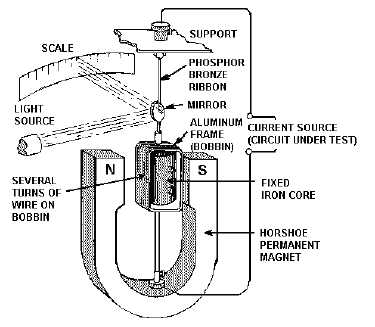3-2
METER POWER SOURCE
Meters are either SELF-EXCITED or EXTERNALLY EXCITED. Self-excited meters operate from
their own power sources. Externally excited meters get their power from the circuit to which they are
connected. Most common meters (voltmeters, ammeters, and ohmmeters) that you use in your work
operate on the electromagnetic principle. All measuring instruments must have some form of indicating
device, usually a meter, to be of any use to you. The most basic indicating device used in instruments that
measure current and voltage operates by using the interaction between the magnetic fields associated with
current flow in the circuit. Before continuing, you might want to review the properties of magnetism and
electromagnetism in NEETS, Module 1, Introduction to Matter, Energy, and Direct Current.
Q-1. What meters operate from their own power sources?
BASIC METER MOVEMENT
A stationary, permanent-magnet, moving-coil meter is the basic meter movement used in most
measuring instruments used for servicing electrical equipment. When current flows through the coil, a
resulting magnetic field reacts with the magnetic field of the permanent magnet and causes the movable
coil to rotate. The greater the intensity of current flow through the coil, the stronger the magnetic field
produced; the stronger the magnetic field produced, the greater the rotation of the coil. The
GALVANOMETER is an example of one type of stationary, permanent-magnet, moving-coil measuring
instrument.
Galvanometer
The galvanometer is used to measure very low currents, such as those in bridge circuits. In modified
form, the galvanometer has the highest sensitivity of any of the various types of meters in use today. A
simplified diagram of a galvanometer is shown in figure 3-1. It is different from other instruments used
for the same purpose because its movable coil is suspended by means of metal ribbons instead of a shaft
and jewel-bearing arrangement often used in other instruments.
Figure 3-1.—Simplified galvanometer.

